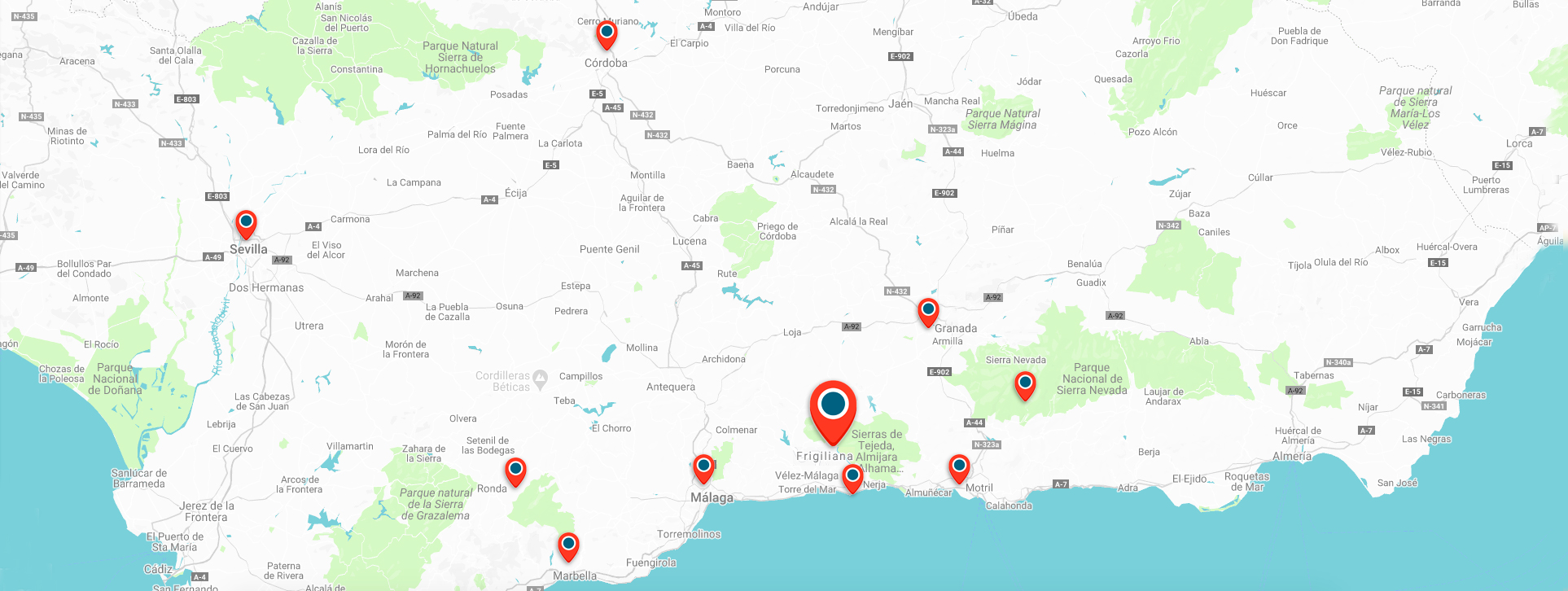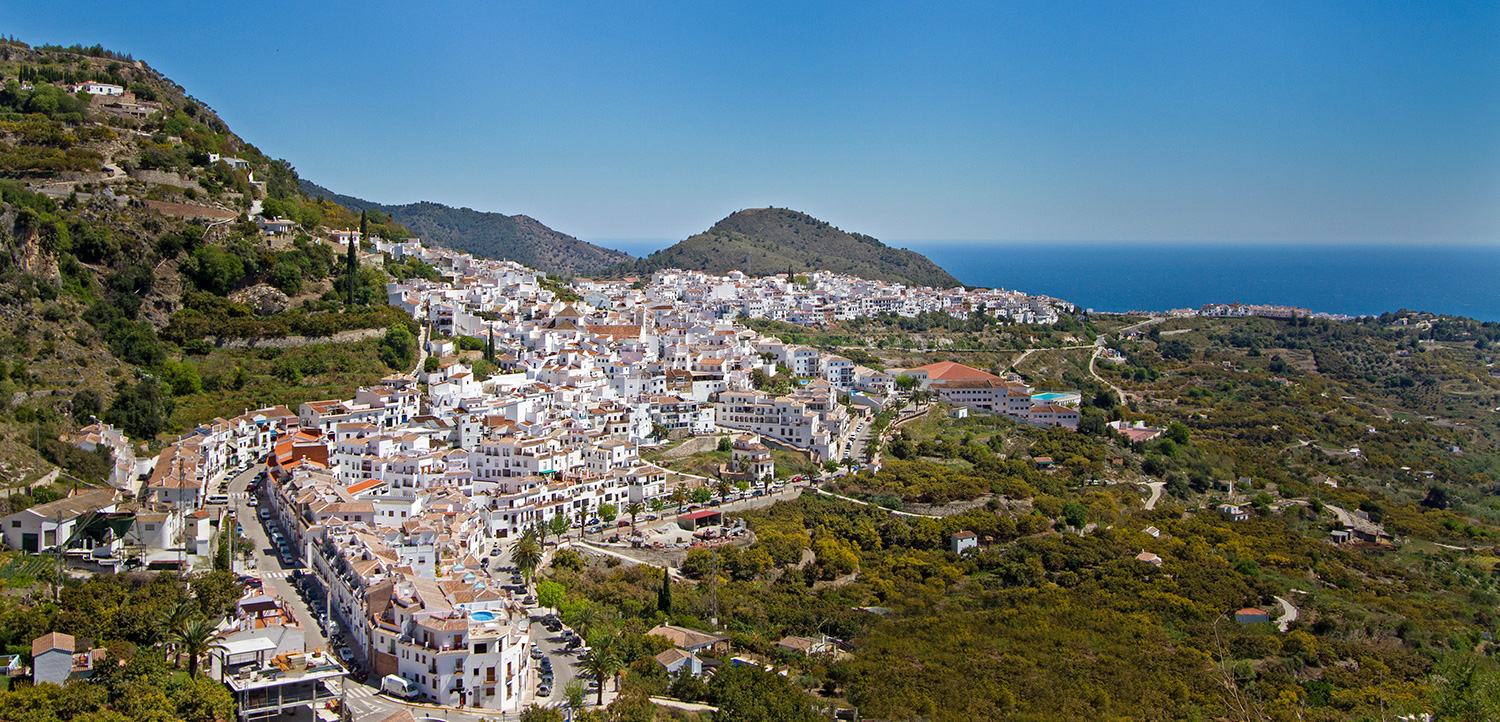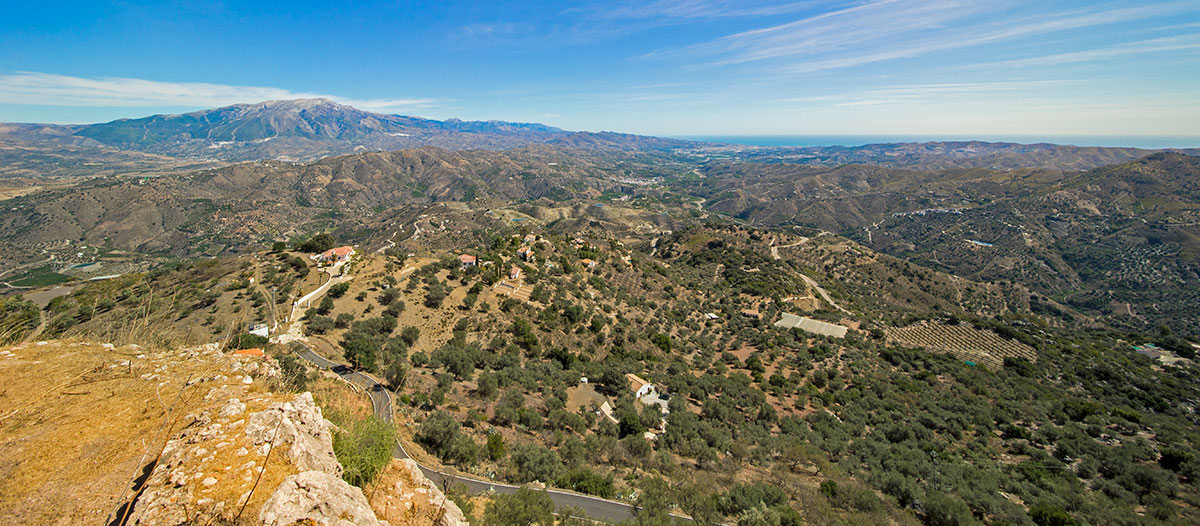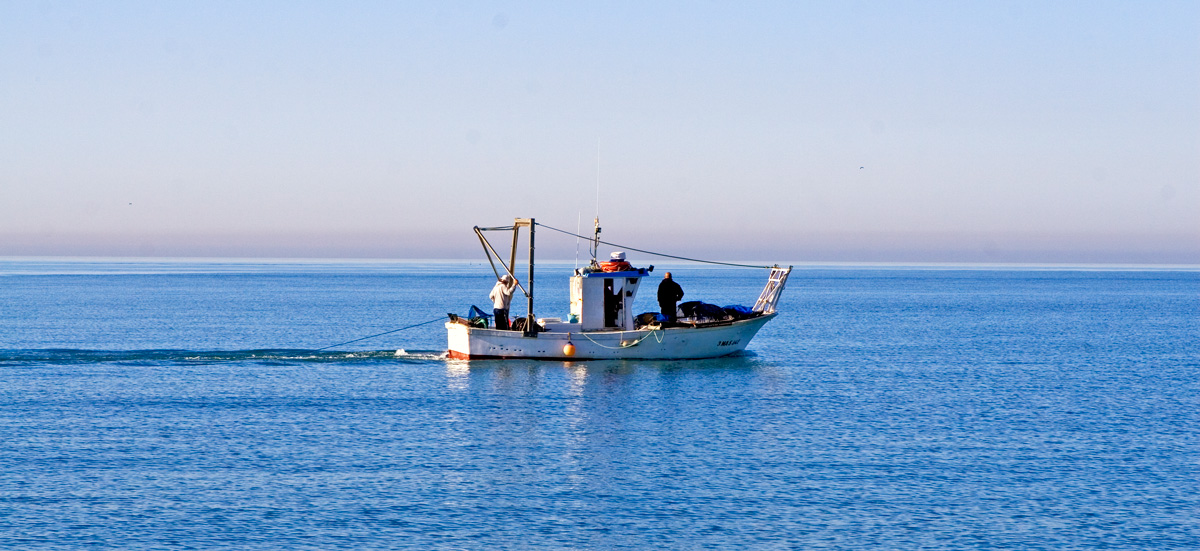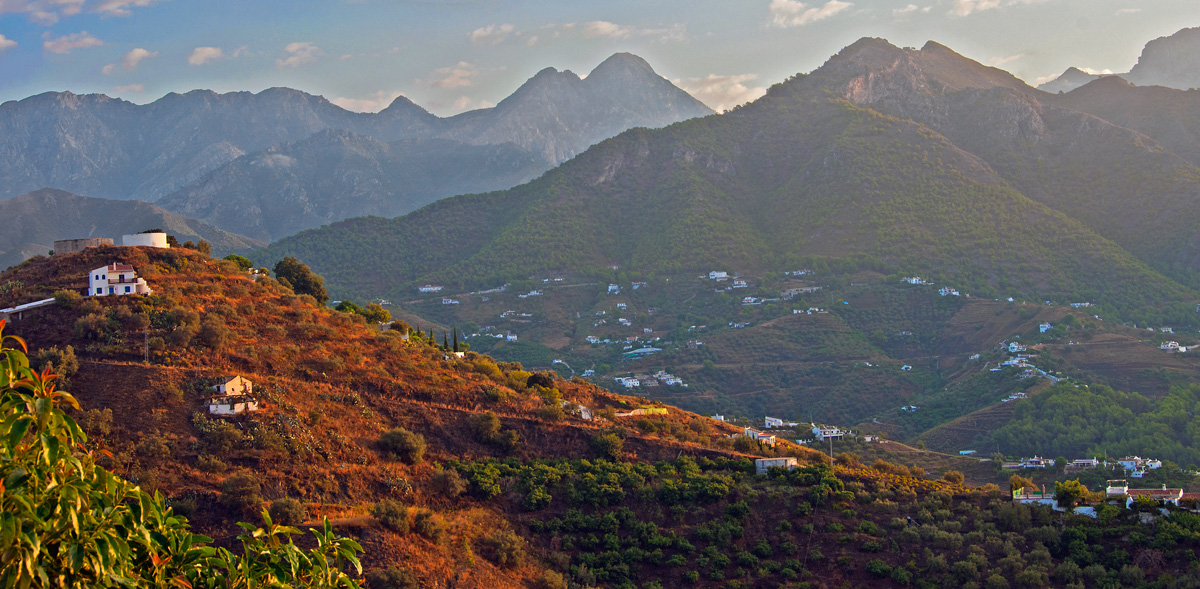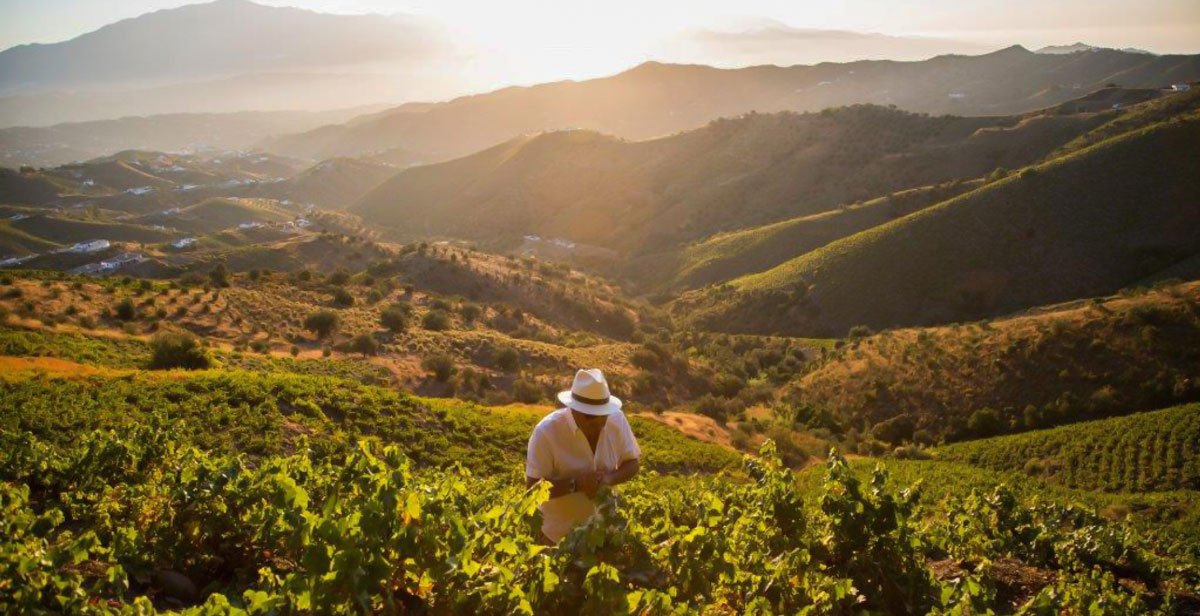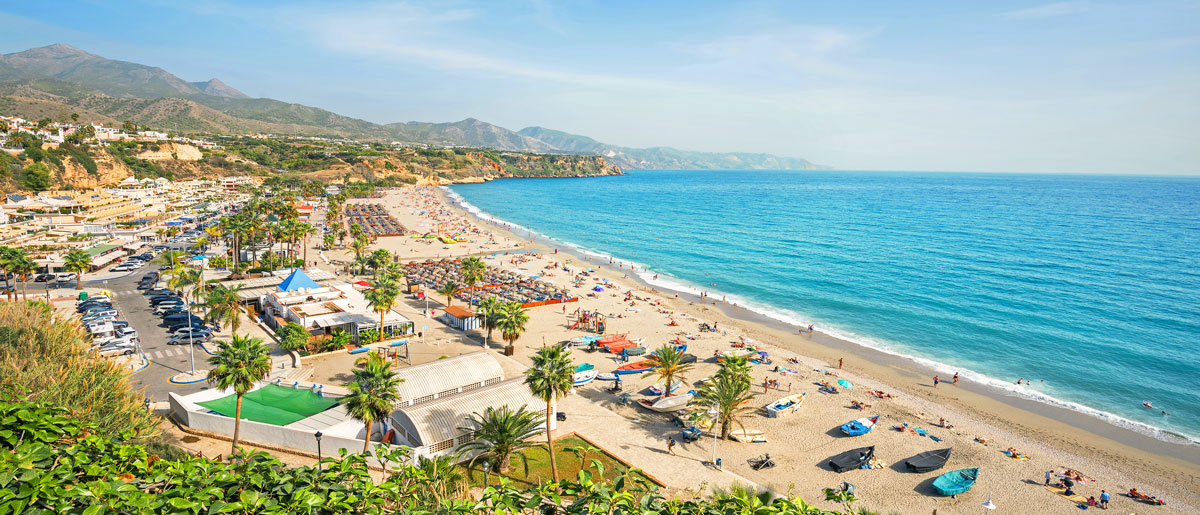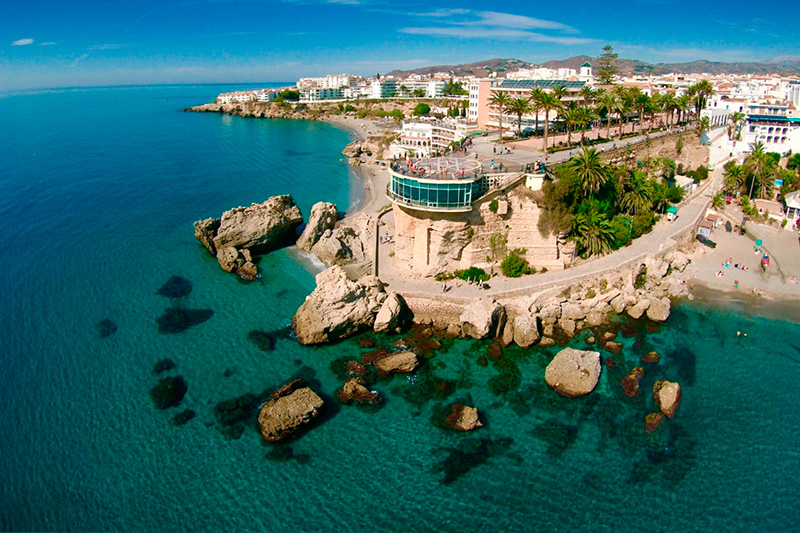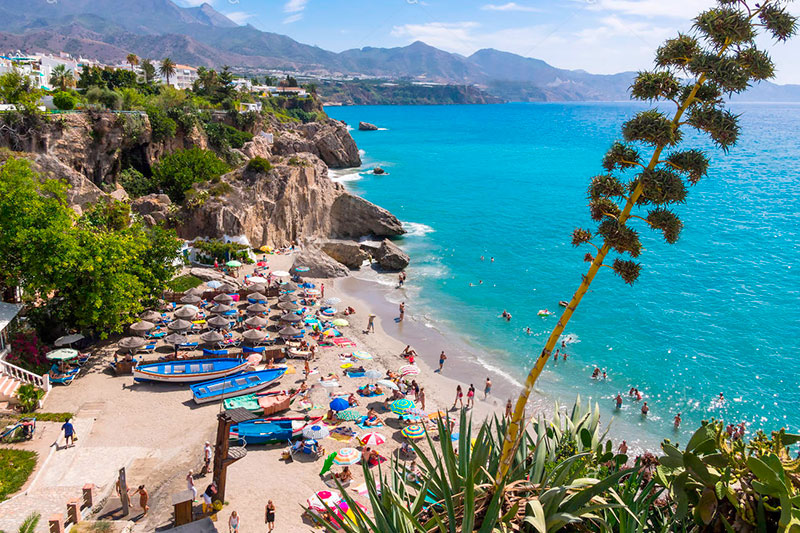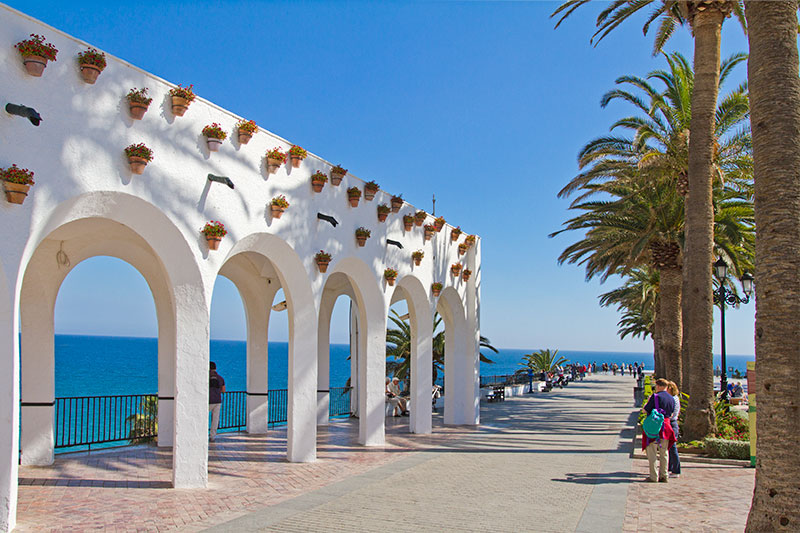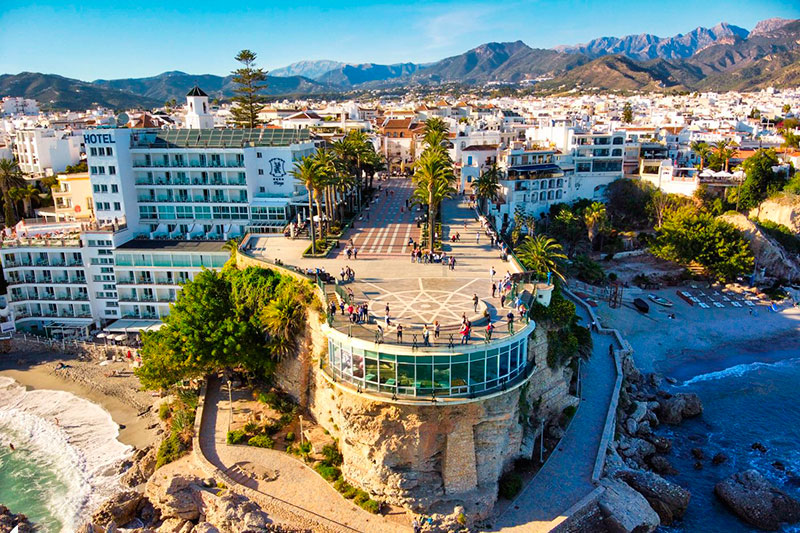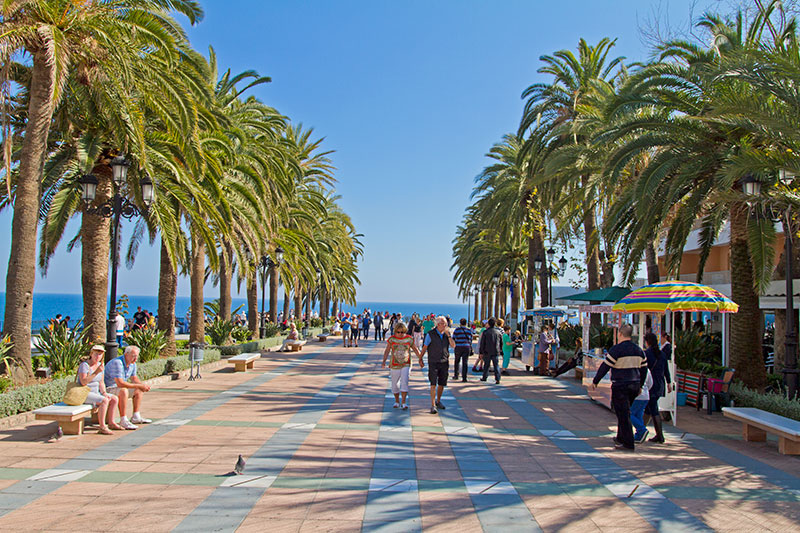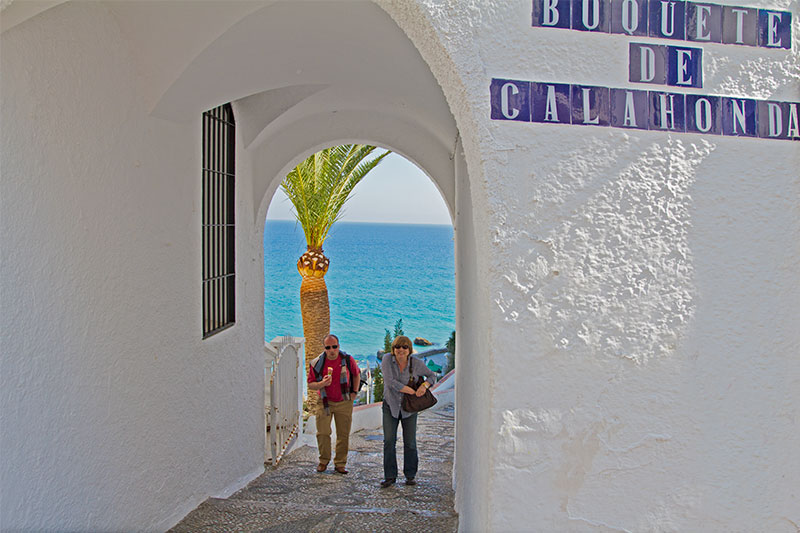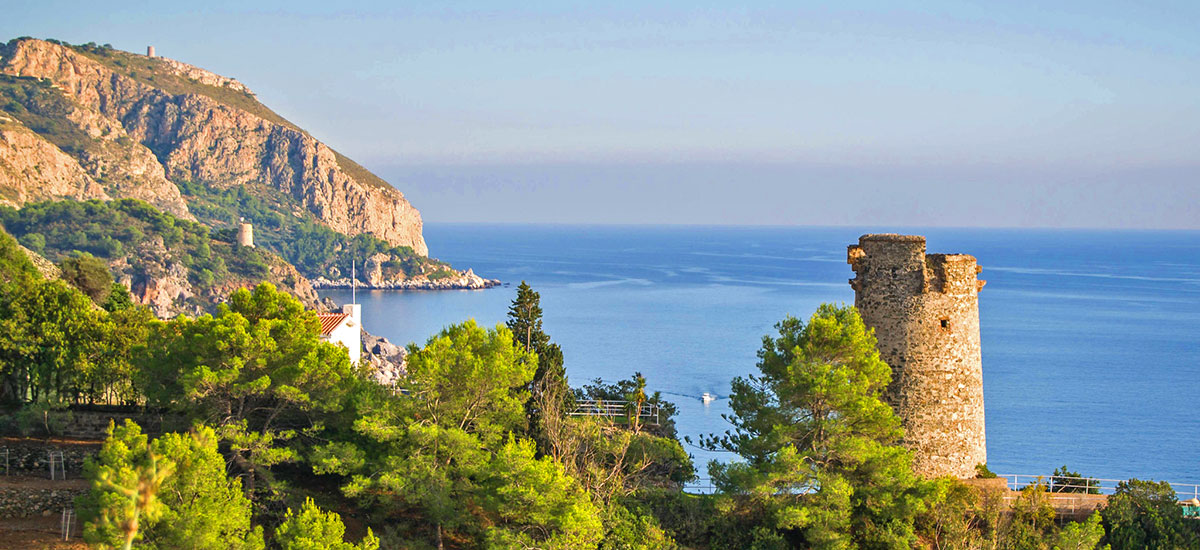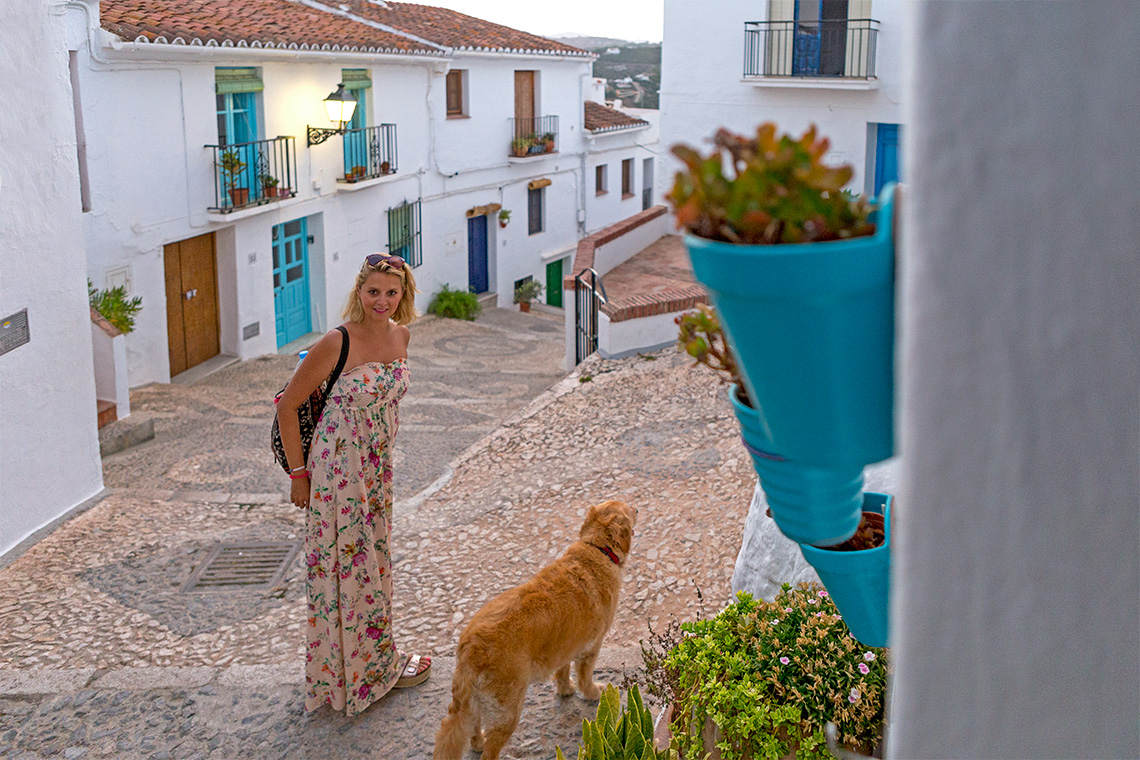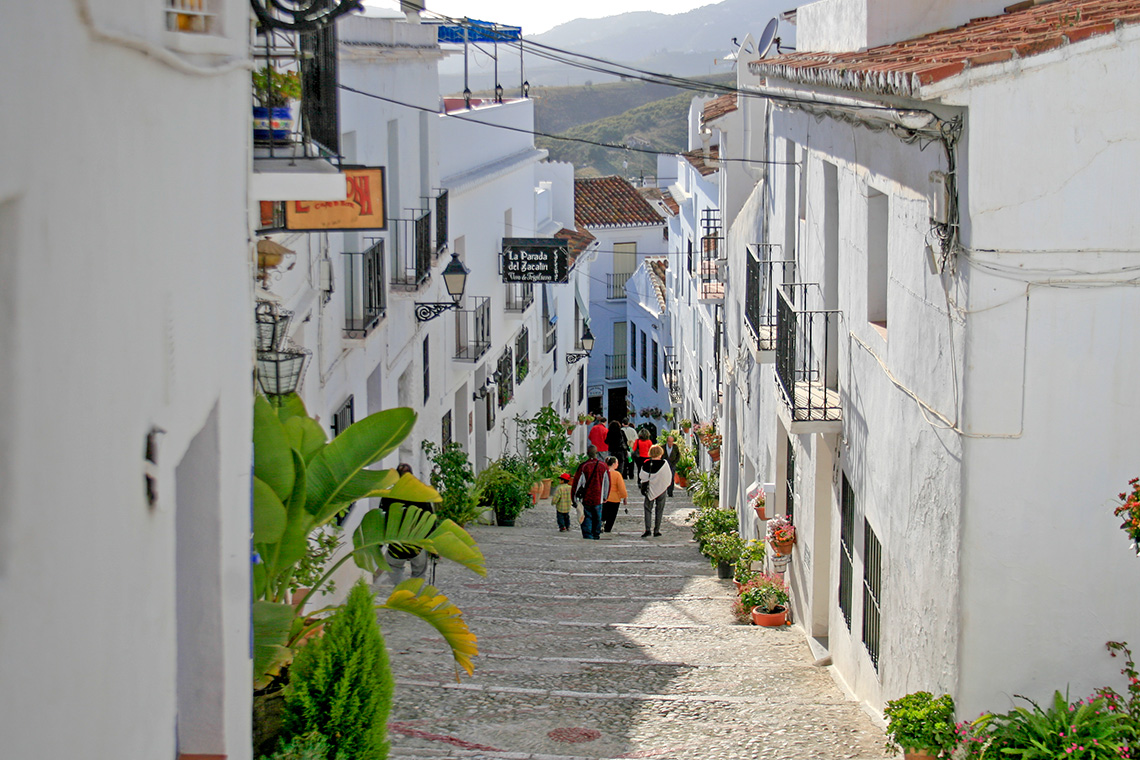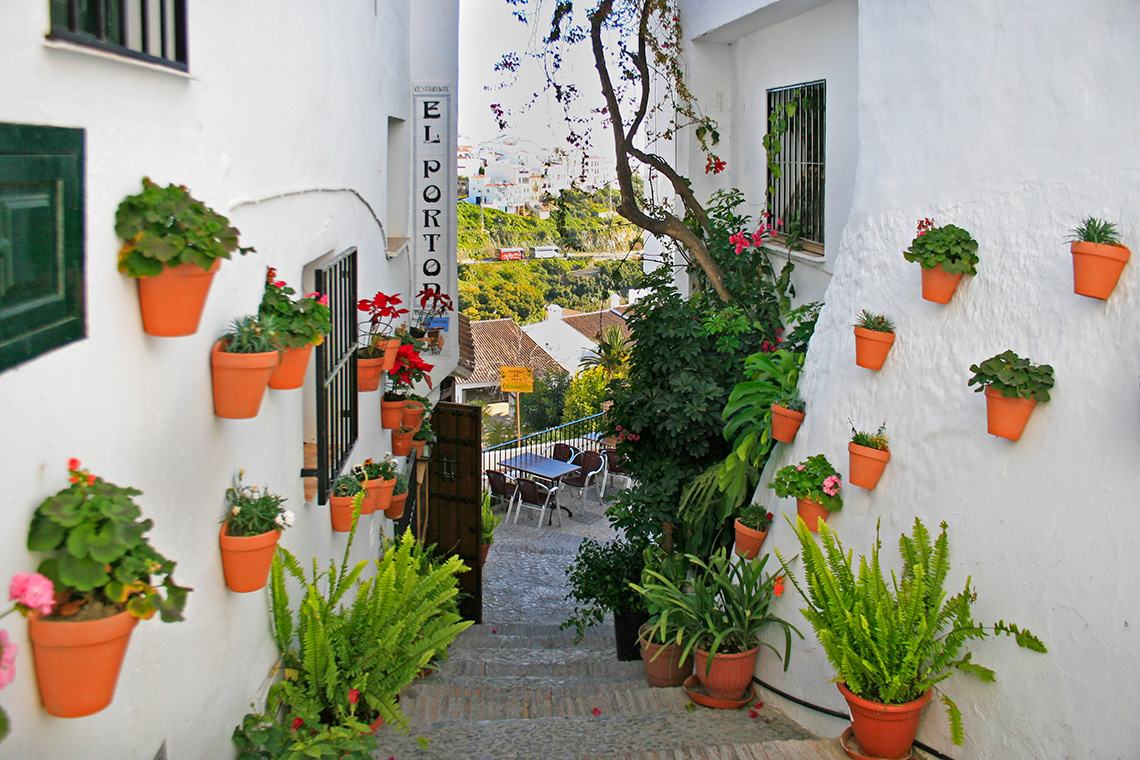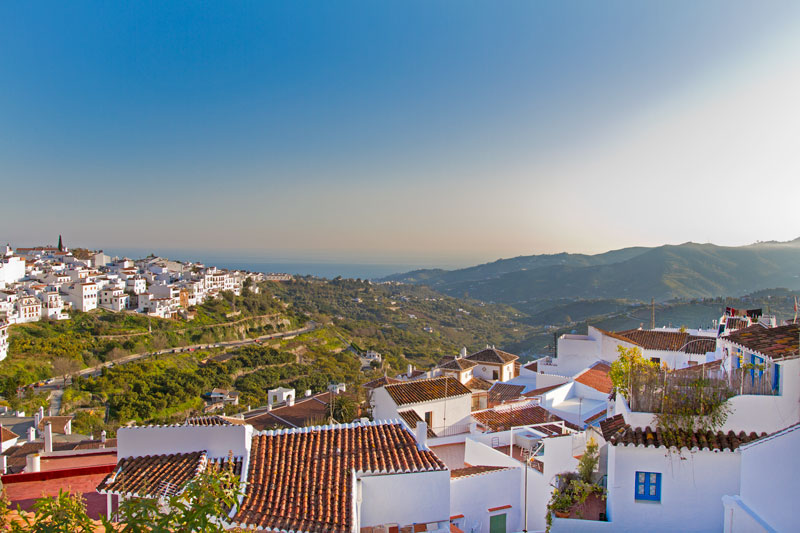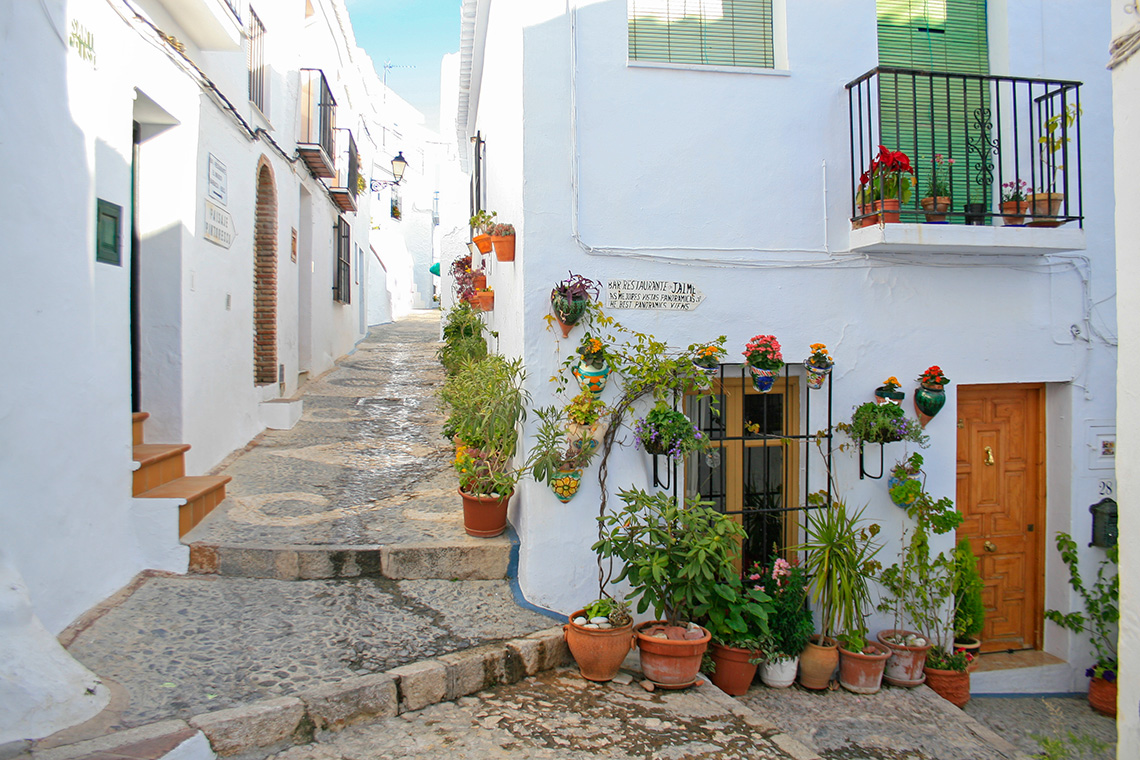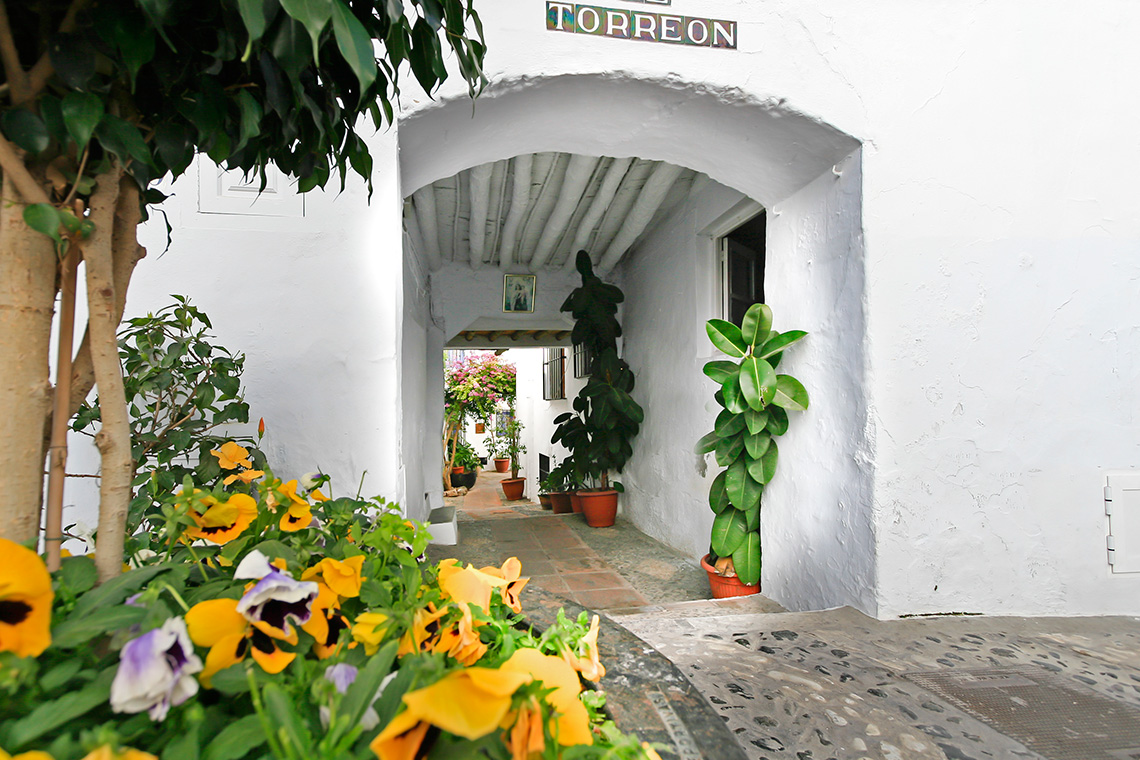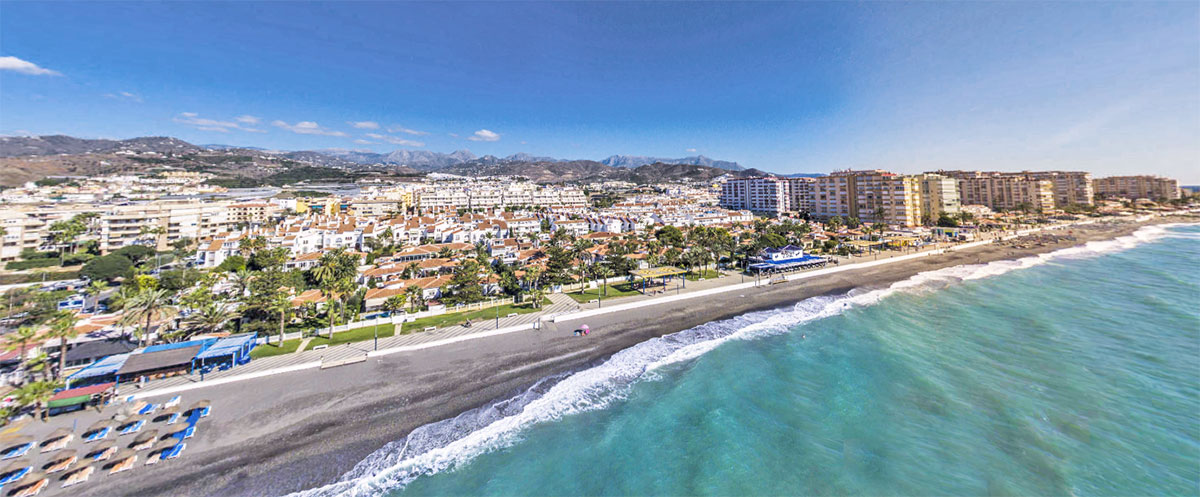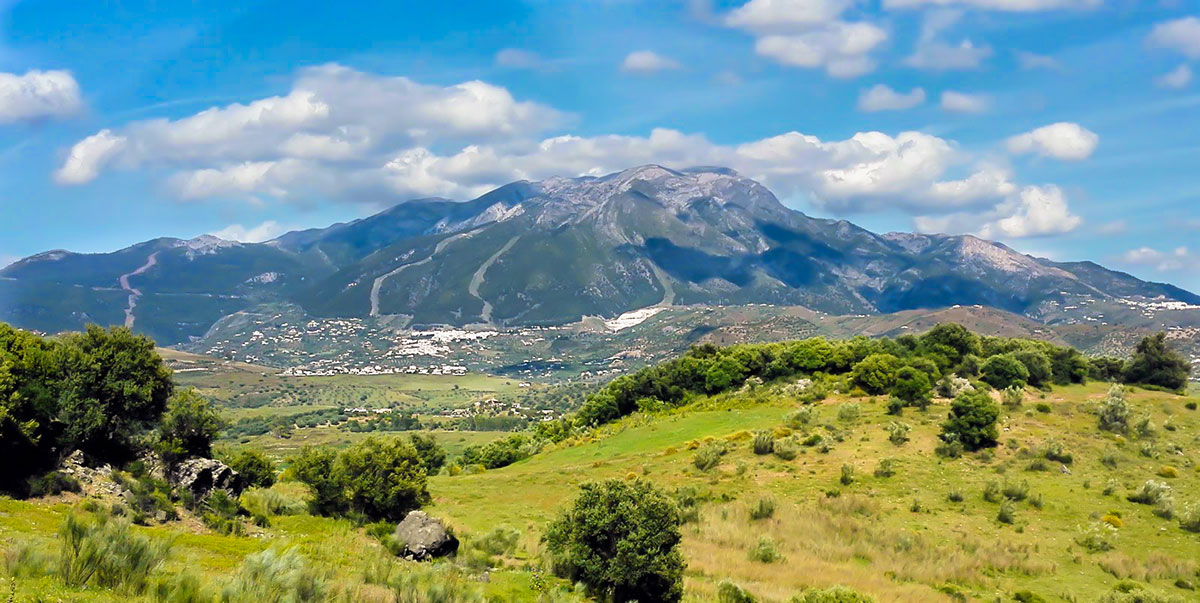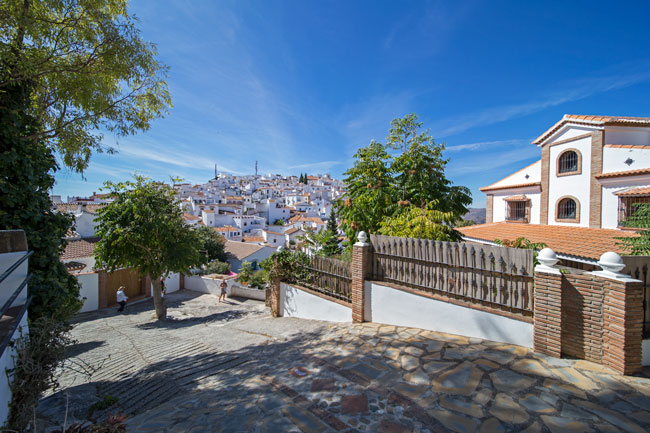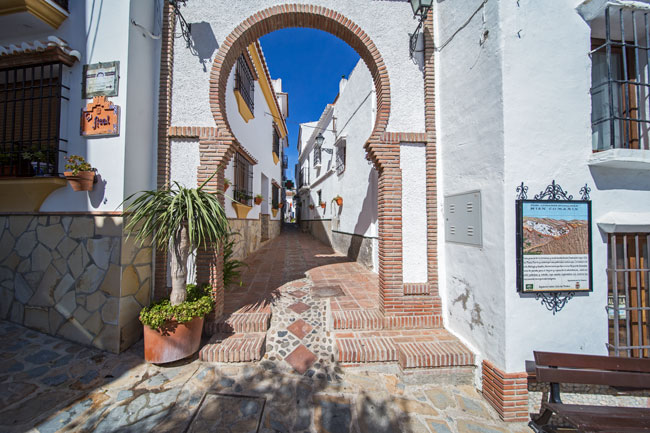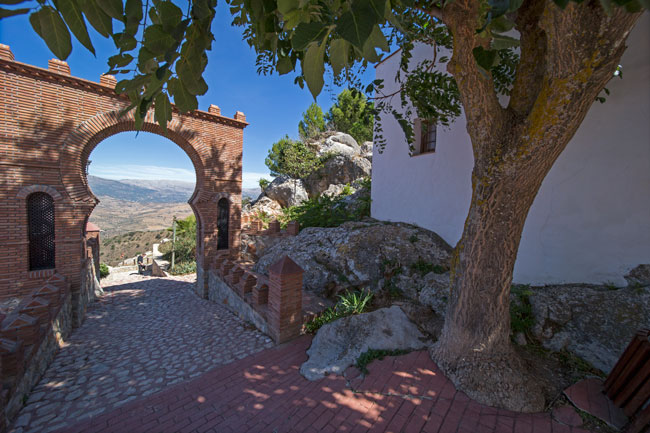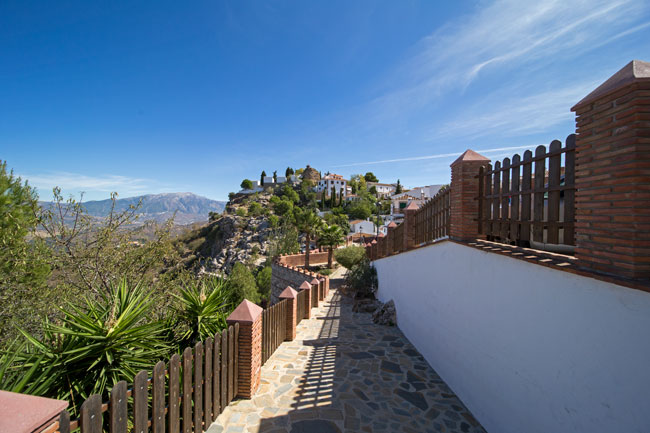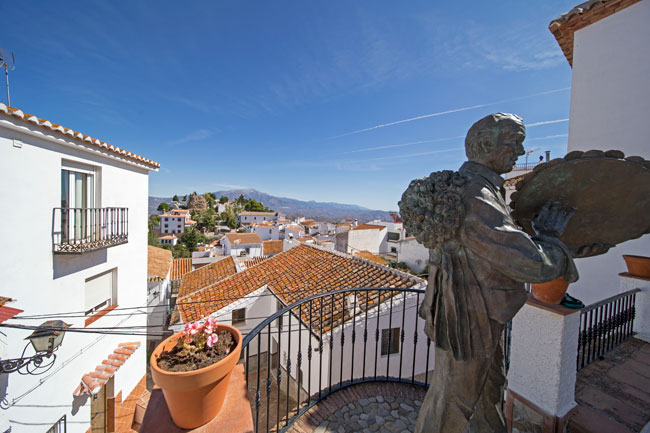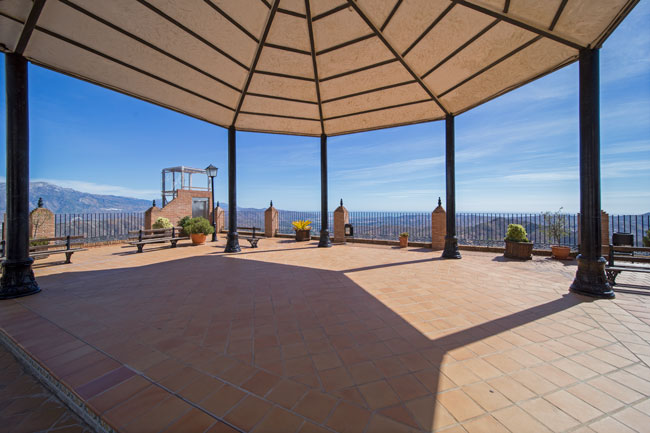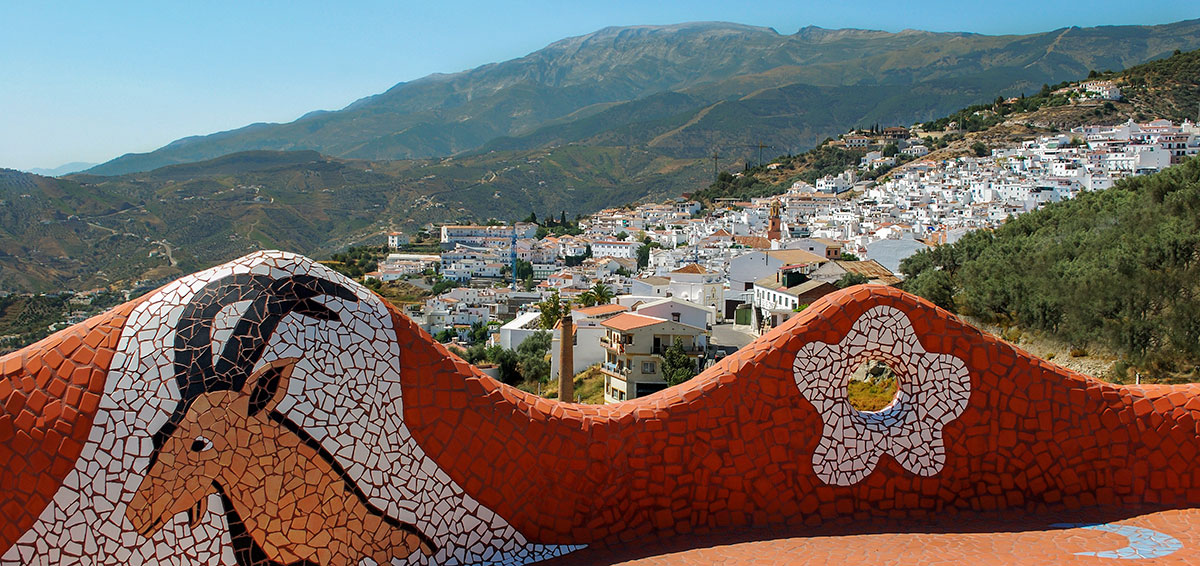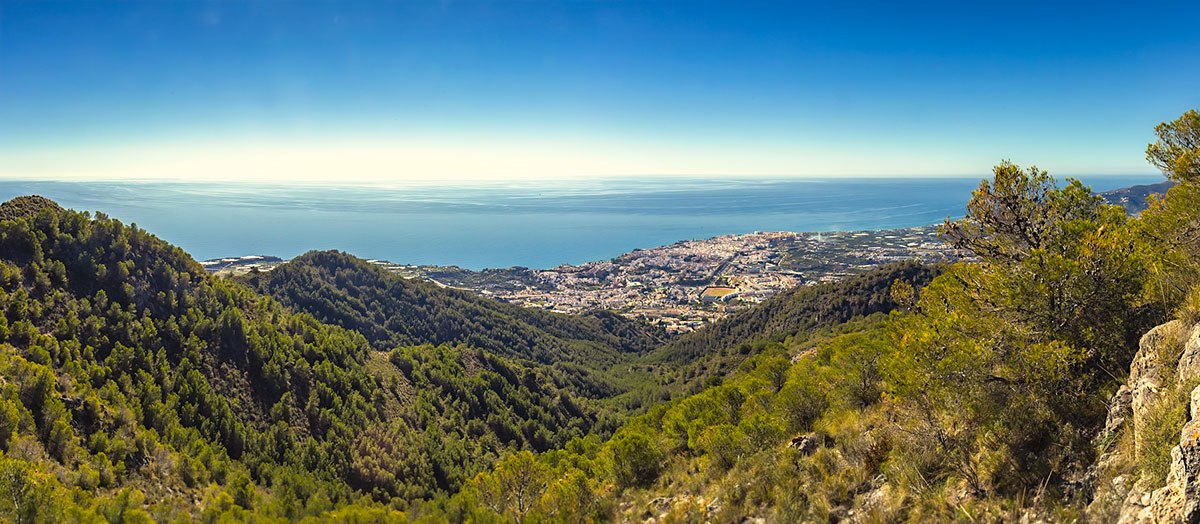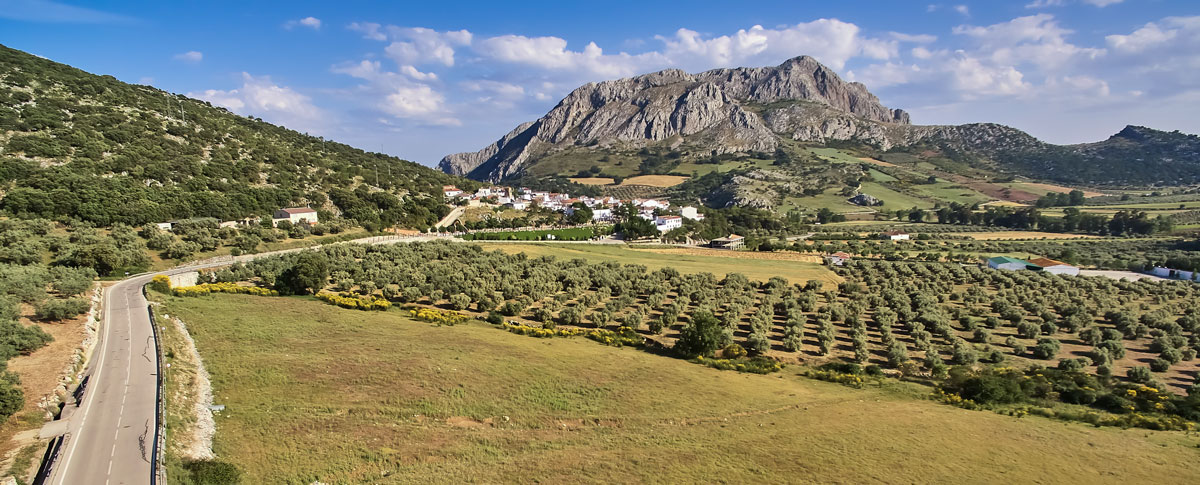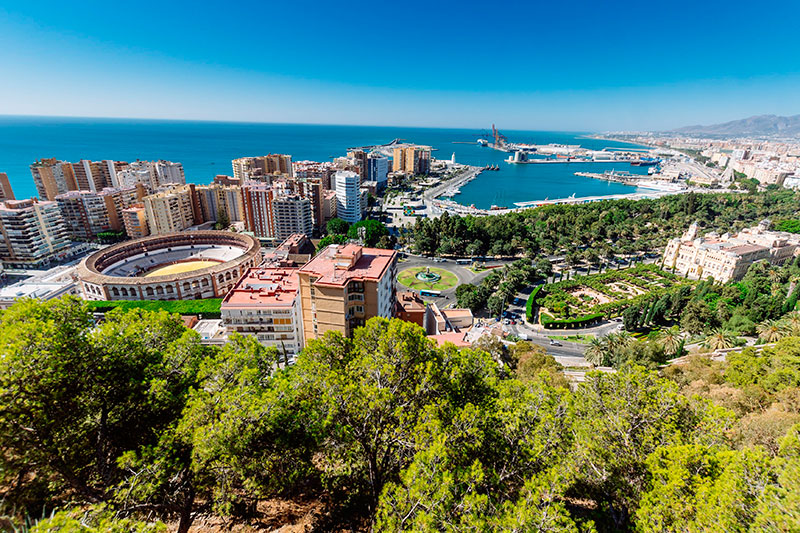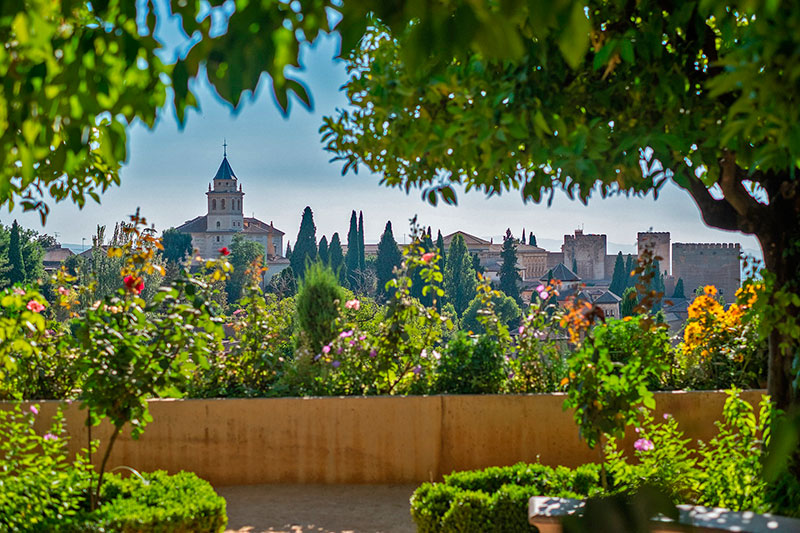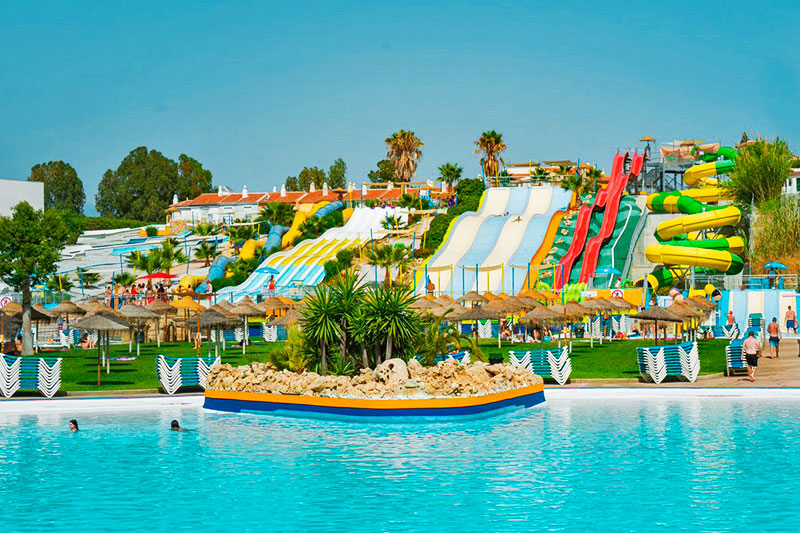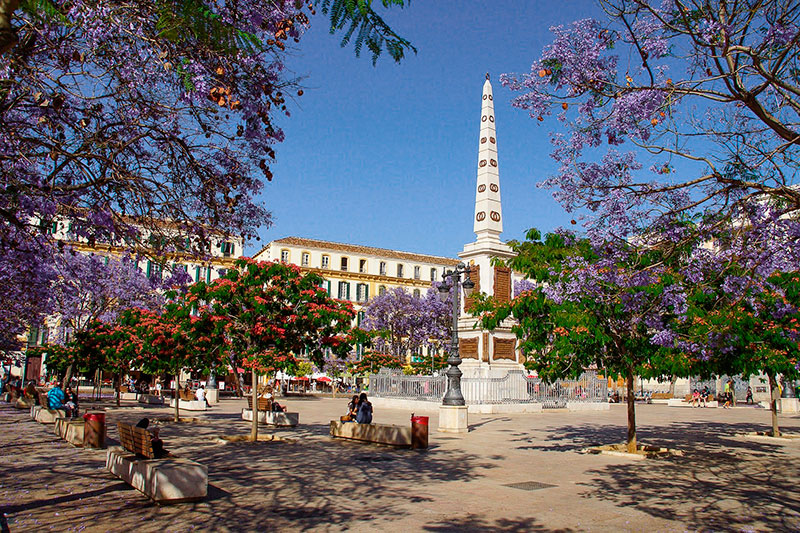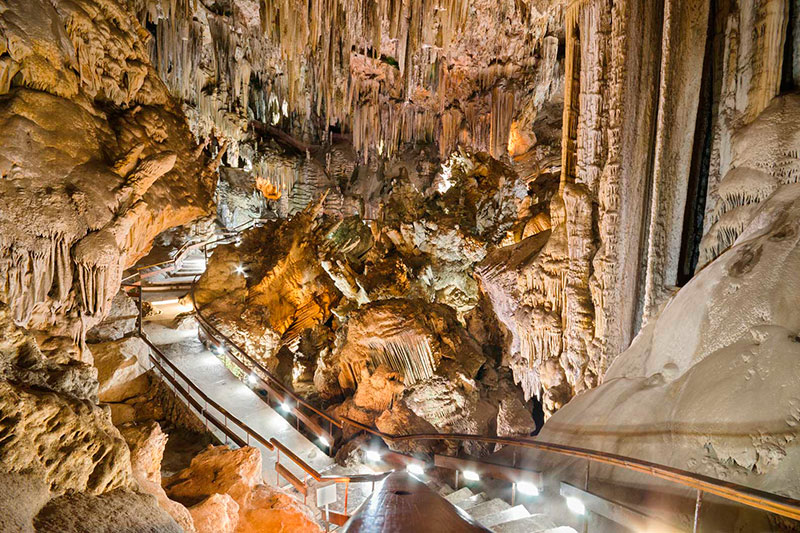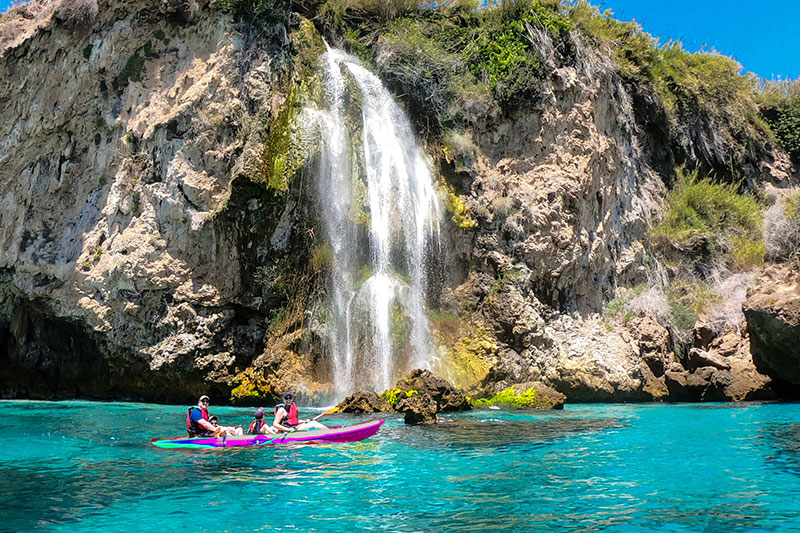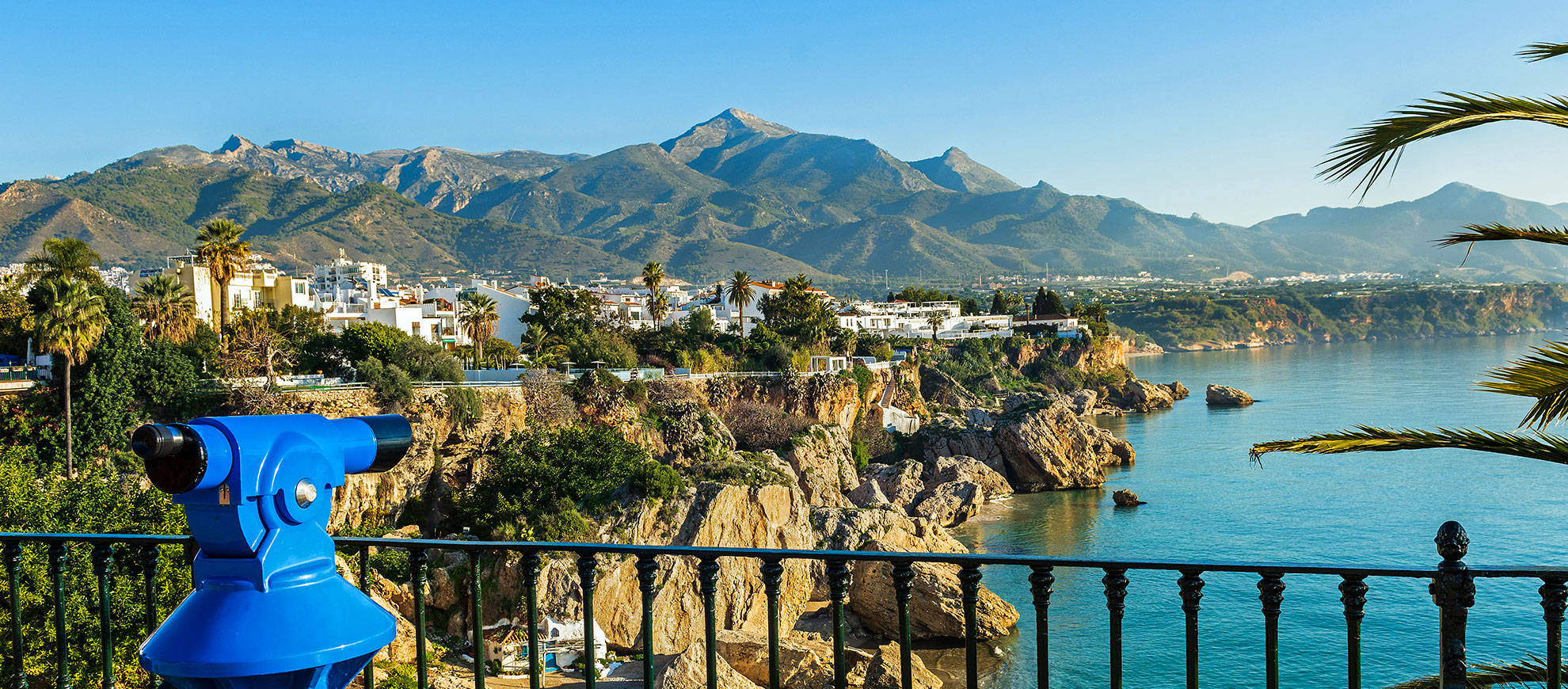
La Axarquía
Here you will find some recommendations, photographs of the village and its surroundings, a map of distances to places, comments from travellers and a selection of villas and rural houses for rent in La Axarquía
La Axarquía, between the sea and the mountains
La Axarquía is a mountainous landscape with olive trees and vineyards, valleys with mangoes and avocados, white houses coloured with flowers, beautiful beaches in Mediterranean style and above all good people.
From north to south and east to west, La Axarquía is changing its seafaring landscape to the mountainous formations that make up the Sierra de Tejera, Almijara and Montes de Málaga. This change means that this area has a high contrast of beautiful landscapes. In just one day we can visit Nerja and Alcaucín, two totally different landscapes but at the same time very close together, two white villages in the whole of La Axarquía.
A changing landscape
The lower part runs through valleys of cherimoyos and avocados, mangos, oranges and sugar cane. As we start to climb the landscape turns into soft hills with almond trees, olive groves, lemon trees and vineyards. The mountains and natural parks of Montes de Málaga and the park of Alhama, Tejeda and Almijara form a natural border. From them we can see some of the most impressive views that La Axarquía has to offer. Many with the sea as their main feature and others with its beautiful green nature.
Mediterranean life in its purest form
Above all, La Axarquía is a region of gentle, rolling and open landscapes, with grapes drying out, with small boats fishing in calm, crystal-clear waters, continuing its tradition of anchovy and sardine fishing. A pure Mediterranean life with the sea in the background.
Agriculture as a way of life
Its people are hospitable, good people, some hardened by work in the fields, others by fishing. Agriculture is their main source of income. Olives are typical as in most of Andalusia, and the quality of the avocados and mangos that grow in a tropical climate is outstanding. The muscatel grape vineyards are another characteristic of the area, and the orange and lemon trees give colour to the hills and valleys. In a large part of the region, agriculture is very complicated, the orography is abrupt, with differences in levels between 40 and 60%.
The Moscatel wine
In La Axarquía there is a lot of wine culture. The most widely cultivated type of grape is the sultana grape, giving rise to good wines such as those from Competa, Moclinejo, Almacahar, El Borge and others. If we want to learn more about the wine culture we can go to the wine cellars in Competa, it will be an authentic visit and you will be able to taste and choose the one you like best. There are also souvenir shops all over La Axarquía where wine bottles are sold.
More than 300 days of sunshine a year
Apart from having more than 30 kilometres of beach, the people of La Axarquía pride themselves on having the best climate in Europe with more than 300 days of sunshine a year. From one end of the coast to the other, from La Cala del Moral to Nerja, we can make a beautiful route by car without leaving the road that is by the sea and the beaches. During the whole route we can find beach bars where we can taste the fried fish and the sardines, typical of the province of Malaga, accompanied with a wine sangria or a fresh beer, it becomes the ideal evening. On the way we find a large number of coastal villages.
Nerja is a charming white village
Of the coastal towns, Nerja has the most glamour and attraction. The centre with its narrow streets, the balcony of Europe, beautiful white houses typical of Andalusia with flower pots full of flowers, and a wide range of villas and rural houses. The beauty of the landscape ranges from the mountains to the sea, with wonderful beaches, and its orchards where you can find tropical plantations of avocados, mangos and cherimoyos.
Nerja has always had a special charm and with the arrival of tourism it obtained its main source of income. Nowadays it is a very active city, and at any time of the year you can find people walking around its streets. Many foreign residents have integrated perfectly into this town on the edge of the Mediterranean.
The intimate coves of Maro
If what we are looking for are beaches with privacy and even nudism, the best thing to do is to go to the Coves of Maro. On the coastal road leading to Granada we will find some cliffs where the best and wildest coves of the provinces of Malaga and Granada are hidden. The views are great, a real attraction for adventure, an invitation to the traveller to go down to the coves. Most of them can only be reached on foot, although you will be rewarded with beautiful sandy coves with crystalline waters. You can practice snorkeling or diving, discovering the wonders that are hidden underwater, with impressive sea beds where corals, sponges and a wide variety of fish live together.
Frigiliana, the pearl of La Axarquía
Of the 31 small white villages scattered throughout La Axarquía, Frigiliana is probably the best preserved and most beautiful. Walking through its streets can be a trip back in time, since it still presents the architecture of the villages of Andalusia from half a century ago, with perfectly preserved old buildings, and with all the mixture of cultures that inhabited these places. The network of streets is truly magical, a picturesque journey through beautiful narrow streets full of flowers and beautiful Andalusian patios… the whole route is full of colour with all kinds of flowers.
Every corner of the Moorish Mudejar quarter has its legend, with many tiles embedded in the facades of the houses that tell stories of battles between Moors and Christians creating some of the most picturesque places. The area around Frigiliana has avocado, mango and vine plantations, which give the whole area a tropical colouring. It has been said by numerous artists that if a village in Andalusia were to be painted, the chosen one would be Frigiliana, as it embodies its most representative values.
Torrox, the best climate in Europe
Torrox has had the slogan of having “the best climate in Europe” for decades. This particular situation is the result, on the one hand, of the proximity to the Mediterranean Sea, which reduces the thermal amplitude, and on the other hand, of the shelter of the Almijara mountain range, a combination that makes its temperatures moderate in both winter and summer. With temperate winters and mild summers, the average annual temperature is 18°C, with no major differences between the two seasons. But this reality is not only a slogan, a scientific study developed by a specialized company, analyzing comparatively the climatic variables of Torrox and other twenty European geographical locations of similar characteristics, all of them tourist destinations, showed that in Torrox all the factors that produce such a climatic balance are combined, which authenticates the slogan of having “the best climate in Europe”. For this reason, it is possible to enjoy its beaches and rural landscape all year round, almost without any difference between the two seasons.
Natural Park of Tejeda, Almijara and Alhama
The mountain ranges of Tejeda, Almijara and Alhama are a Natural Park that divides the province of Malaga and Granada in a natural way. Among its mountains is the Maroma with 2.068 m, the highest mountain in the province of Malaga. At the top of the mountain are the mountain goats with an abundant number of specimens, while the golden eagles control the higher areas. There are walks that lead to waterfalls of crystalline water between high pines and springs that emerge in Alcaucín, Canillas de Aceituno and Sedella. There are many hiking routes.
Comares, the balcony of La Axarquía
From Velez-Malaga we can see a little white spot on top of a mountain, the village of Comares. It has been a settlement and fortress throughout the centuries, it was desired and conquered by the Phoenicians, Romans, Arabs and finally the Christians. Comares is surrounded by strawberry trees, vineyards and olive trees, crops that we find along the way and that give colour to the landscape. The access is not easy, but that fact has preserved the village, making it a picturesque and well preserved place in all its architecture. Streets in the purest Andalusian style, whitewashed, with flowers painting the facades of the houses in many colours and with its narrow streets still breathing the Nazari air. At 700 metres above sea level from the Balcón de Europa or from the cemetery area we have a truly impressive, exciting view of La Axarquía.
Competa, the wine festival
The town of Cómpeta is located more than 600 metres above sea level, within the Sierras de Tejeda and Almijara. Its historical centre is steep and winding, with white houses and remains of Moorish, Roman and Christian traces. Its most frequented street is Calle San Antonio, located behind the square and which divides the town into two neighbourhoods. Its main monument is the Church of Nuestra Señora de la Asunción. Every year, when the 15th of August arrives, the Night of the Wine is celebrated, a festivity with a lot of tradition, with a meaning in key of work, it marked the date of the beginning of the workers who went to the grape harvest or collection of the grapes, and as a sign of affection they were given a farewell party.
Montes de Málaga Natural Park
The Montes de Málaga Natural Park is the lungs of the city of Málaga, acting as a spiritual frontier between the hustle and bustle of the city and La Axarquía. With a total of 5,000 hectares, the park has various hiking and cycling routes, with areas heavily populated with pine forests, cypresses, holm oaks, cork oaks and riverside vegetation. In season, there is a great variety of mushrooms and wild animals abound with the wild boar, wild cat, badger and a great variety of birds such as eagles and owls. The path that leads from Malaga to Fuente de la Reina runs through a large part of the nature reserve and there are a large number of ventas where you can eat their typical dish, “El plato de los Montes”, which consists of fried eggs, chorizo, fried green peppers and pork loin in lard and takes away your hunger until the next day. If we are lucky we might find a “Panda de Verdiales” in one of the sales. The verdiales are a kind of archaic-musical monument, a jewel of Malaga’s cultural heritage.
Alcaucín and Periana, the Upper Axarquía
Alcaucin is located at the foot of the Sierra Tejeda mountain range, a natural park with a rich flora and fauna and many options for true nature-loving walkers. The privileged location between the mountains and the sea provides a pleasant temperature and allows the vines and olive trees to grow strong to give us a muscat wine and olive oil of wonderful qualities.
Periana is an important agricultural centre for olive trees and its peaches are famous for being the best in Spain. In the north of the municipality there is still the Muslim testimony in the Baños de Vilo, a spring of sulphurous waters. Between the two villages we find the Boquete de Zafarraya, an impressive cut between mountains that forms the natural pass to the province of Granada.
More about La Axarquía
You can visit the caves of Nerja, Malaga city is less than 1 hour from Nerja, there are beach bars all along the coast, for children a water park in Velez Malaga, the Aquavelis, also in Velez Malaga the largest shopping centre of the Axarquia, El Ingenio, there are activities aimed at both water and land, the ancient city of Granada with the Alhambra less than 1 hour, the Alpujarra 1 hour, in short a place in the world that everyone should visit.
